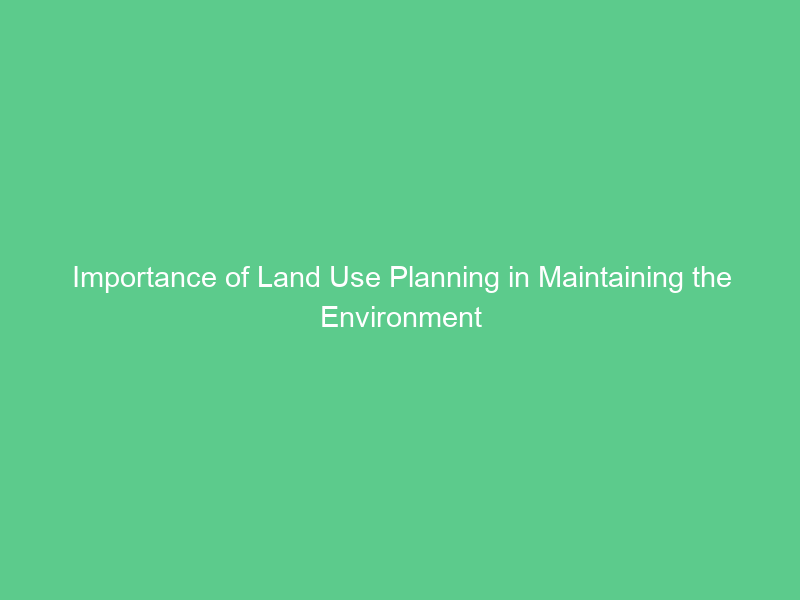Land use planning can play an essential role in protecting our environment by providing for residential, industrial and commercial zoning requirements; managing natural resources like water and land for agriculture purposes; protecting monuments and national parks. It provides essential assistance for protecting monuments.
Without careful land use planning, transportation systems would become ineffective, homes could be exposed to environmental hazards and economies would stagnate. Land use planning aims to balance competing private interests while providing residents with a higher quality of life.
Social
Land use planning involves the design of urban and rural environments to meet the needs of communities. It entails consideration for issues like environmental health, economic development and infrastructure as well as zoning practices which govern which activities can take place on certain parcels of land.
Land use planning has multiple social ramifications that differ depending on its implementation and location. For instance, sprawling growth patterns that disperse residents across large areas are unsustainable and consume resources faster than they can be replenished.
Sociology must focus more on studying zoning and land use practices that foster social segregation and ethnic cleansing, such as those documented in the US. Sociologists should devote greater attention to studying these practices since they play such an integral part of housing inequality. Furthermore, sociology of housing should address power dynamics involved with planning processes – for instance the role property ownership plays in modern society and how land use plans contribute to further economic and racial stratification through land use plans.
Economic
Economic impacts of land use planning include providing affordable housing, supporting sustainable transportation systems and developing vibrant communities. Cities that fail to consider these issues risk experiencing basic service deficits, inadequate infrastructure requirements and congestion that lead to poverty and inequality. Decisions concerning urban land-use must take into account market dynamics as well as challenges related to reduced costs for infrastructure services and labor costs – decisions must also take into account market dynamism while taking advantage of any agglomeration patterns that exist while reflecting those challenges as part of making informed choices for sustainable living environments.
Land use planners also consider how land-use changes impact local business, including separating residential from commercial zones, lowering noise levels in residential areas, and safeguarding natural areas.
There is only so much habitable space on earth, so land development professionals must collaborate to create the safest, most productive, efficient environment possible. Land use planning can assist them in this endeavor while protecting biodiversity while simultaneously accommodating for residential, industrial, or retail uses.
Environmental
Land use planning plays a crucial role in shaping our environment, from biodiversity conservation to climate regulation. An effective plan can protect natural habitats, control industrial development near sensitive ecosystems and increase community resilience against climate-related hazards through strategic infrastructure placement.
Zoning laws can create green spaces to allow wildlife movement between urban areas and wild spaces, or designate agricultural land for sustainable practices that support both crop production and habitat preservation. Such initiatives help mitigate environmental hazards by reducing carbon dioxide emissions, improving air quality, and increasing water availability.
Equity planning (EJ) seeks to ensure equal access and burden sharing from environmental impacts on all. Policies designed around EJ may include providing affordable housing options, improving public spaces and amenities access and inclusion in planning processes and ensuring fair participation by low-income and people of color communities in planning processes – helping address environmental and health disparities at a localized level.
Physical
Land use planning has an immense effect on our physical world, from biodiversity conservation to climate regulation. It determines how cities, towns and rural areas are laid out while simultaneously meeting economic and social objectives while protecting environmental assets.
Commercial zoning provides spaces for business and retail establishments, often dictated by traffic patterns and proximity to public transportation stations. Industrial zoning permits manufacturing and warehousing activities while taking into account environmental impact considerations and keeping distance from residential zones.
Recreational zoning creates spaces for outdoor sports and activities such as golf courses, horseback riding centers, parks, open green spaces and playgrounds – helping promote healthy living while supporting local economies through jobs creation and tourism attraction. Furthermore, recreational zoning plays an essential role in protecting both nature and people living there.

